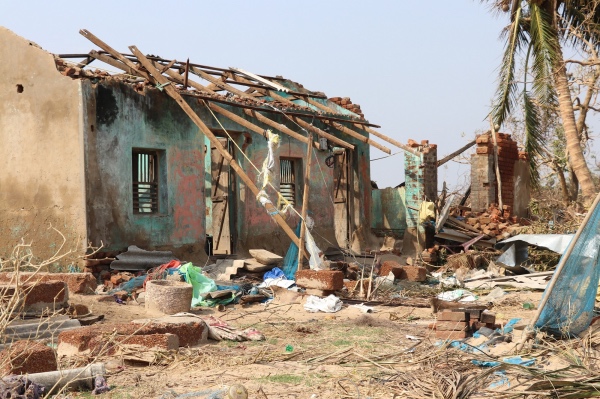Chennai, India
Thomson Reuters Foundation
From the safety of a relative’s house, Mohammed Tazmul Hussein watched coconut trees crashing onto the roof of his home as Cyclone Fani barrelled into eastern India.
Two weeks after the cyclone struck Odisha state on India’s east coast, travelling at 200kph and forcing the evacuation of more than one million people, Hussein is struggling to pick up the pieces and rebuild his home.

Houses damaged during Cyclone Fani in Motto village of Bhadrak district in eastern state of Odisha, India, May, 2019. PICTURE: Courtesy PLAN India
As well as having no electricity, not enough clean drinking water and no tree cover, thousands like Hussein are now exposed to heatwave conditions with temperatures of 40 degrees Celsius.
“We live by the coast and have never had to bear the intensity of summer like those in western parts of the state,” Hussein, 53, told the Thomson Reuters Foundation over the phone from Bhagwanpur village near the temple town of Puri.
“But the cyclone took away all our shade giving trees and uprooted electricity poles. And with electricity yet to be restored, the heat is sapping. I feel helpless.”
Fourteen districts of Odisha felt the impact of Cyclone Fani on 3rd May. More than 10 million have been affected by the worst summer cyclone in the state in 43 years, according to government data.
Hussein’s house is one of the more than 500,000 that were damaged in the cyclone, that destroyed crops, contaminated water bodies and snapped communication and power lines.
“There are people who stood near the rubble, unable to recognise what was left of their homes,” said Tushar Kantidas, senior manager for disaster risk management with charity Plan India.
“People have lost everything and there is an urgency to rebuild, with food and shelter being a priority. But the rising temperatures have become the new challenge.”
Odisha’s Special Relief Commissioner Bishnupada Sethi has switched gears from cyclone preparedness to putting systems in place to deal with the rising temperatures.
Credited for organising a major evacuation ahead of the cyclone that contained the death toll to 64, Sethi said rising heat had become the biggest challenge for quick rehabilitation.
He said they had issued an advisory to people to stay indoors between 10.30am and 3pm.
“But that’s when many are stepping out to reconstruct their homes,” he said.
In Puri district, where the cyclone made landfall, the administration has so far provided electricity to three percent of about 290,000 people affected while the National Disaster Response Force was clearing roads of trees and electric poles.
“Families are desperate to restart their lives before the monsoons hit next month and are exposed to the heat as they spend the entire day salvaging what is left of their homes,” said Samuel Behera, an executive with charity Smile Foundation.
“Source of electricity and tarpaulin sheets to cover the exposed roofs are urgently needed but short in supply.”
Behera said sourcing solar lights for families left in pitch darkness was becoming a challenge as costs had shot up.
For Hussein, cyclones are not new. He remembers stories from his grandfather and father about surviving “big cyclones”.
“We have learnt to live with the cyclones, quickly recovering and getting back to normal,” he said.
“But this time we are struggling, spending the nights in darkness and the days in scorching heat. I feel like crying even as I talk to you today because I don’t know how long it will be before I am back home and happy.”





